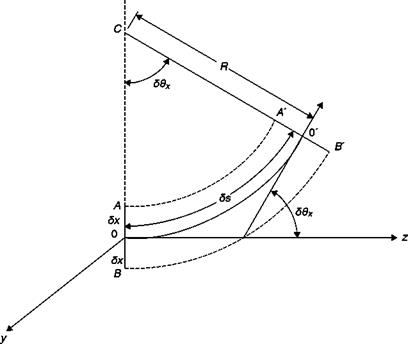Deflection of a light beam in the presence of a constant gradient of refractive index
Assume that the beam, which initially propagates in the z direction, encounters a zone where there is a gradient of refractive index
Deviation of a light beam in the presence of a constant gradient of refractive index
![]()
|
(Figure 6.15). Denoting with n the refractive index at the point 0, at points A and B of the beam, at a distance of ±8x from the z axis, the refractive index takes the values respectively:
Эл Эл. ,
nA = n+——ox nB = n – — ox (6.3)
dx dx
Since there is an inverse relationship between the refractive index and the speed of light, c, the speed of light at points A and B is such that:
dn s
л——- ox
![]()
![]() dx dn „
dx dn „
n+— ox dx
therefore, the beam deflects toward the positive x axis. After a time, 8t the wave front AB is in the position A’B’ deflected by the angle 8Qx with
 |
|||
respect to AB. The rays passing through A and B in time 8t travel distances SsA and 8sB proportional to the speeds cA and cB, respectively. Indicating with R the radius of curvature of the ray passing through the origin of the axes, we can write:
which yields:
which is the required relationship between the deflection of the light rays and the gradient of the index of refraction.
Similarly, if there is a gradient of n in the y direction, constant and greater than zero, the beam undergoes a deflection towards the positive y axis given by:
So, =1 ^Ss
n dy
The total deflections that the beam suffers through a test chamber of width L are therefore, respectively:
where s can be replaced with z as the deviations are usually infinitesimal.












